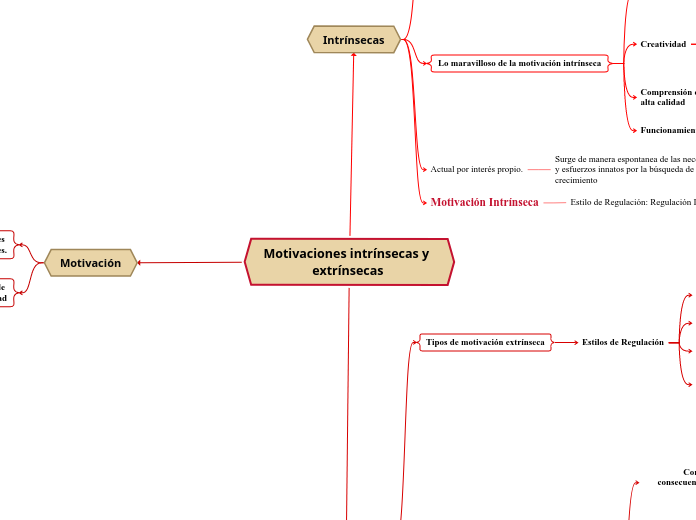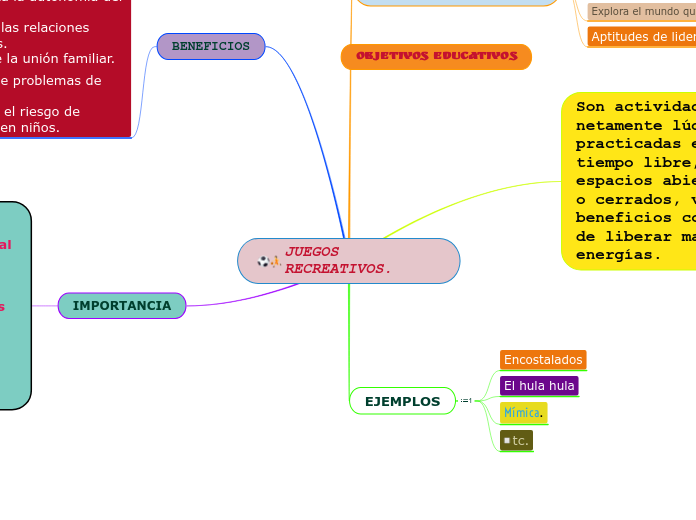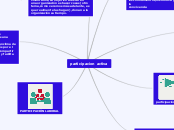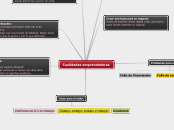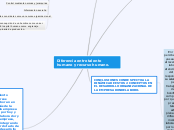Motivaciones intrínsecas y extrínsecas
To name your story, you have to think about the overall message and what you want your audience to understand from the story. Also, make it relevant and easy to remember.
Motivación
The ending of a story is essential. We all know that if the ending is weak, what happened before loses its importance. So make it unpredictable, but fair. A resolved ending answers all the questions and ties up any loose threads from the plot.
La experiencia determina las dos maneras de disfruta r el realizar una actividad
This is the closure section of the story.
See examples of possible outcomes below:
- all problems have been solved
- it's clear how each one of your characters ends up
- your main character is transformed by the challenge
Intrínseca
Try answering these questions to come up with a closure:
- Have all the problems been solved?
- Is there a clear picture of what happens with each character in the story?
- Has the challenge transformed your main character?
- How do the characters feel in the end?
El comportamieno por las necesidades isiologicas, psicologicas y sociales.
This is the moment when the main character surpasses the last obstacle and finally faces their greatest challenge.
The climax usually follows one of these patterns:
- realization
- resolution
- choice
Type in your answer.
Un musico puede tocar su instrumento por el interes en el desarrolo de habilidades valiosas o por sentirse bien con sigo mismo. Asi mismo puede hacerlo para obtener dinero o estatus social con el reconocimeinto y ganancia de premios.
Extrínseca
The middle of the story is where you add layers of complications that will lead to the end. Reveal more about the character's journey. Did their personality go through changes? How did they overcome the challenges? And as you build up the story’s central conflict, make it more personal to that character. Also, from the middle act, you have to lead into the final act.
Proviene de los incentivos y consecuencias en el ambiente, como el alimento, dinero, alabanzas, atención y otros.
Your character(s) need(s) motivation in order to solve the challenge(s).
Regulación Externa de la Motivación
Secondary characters might also have motives that lead them to cross paths with the main character or which might trigger them to help the main character.
Su estudio gira al rededor del lenguaje y la perspectiva del condicionamiento operante.El cual hace referencia al proceso por el cual una persona aprende a operar de manera eficaz el ambiente.
Eficaz hace referencia a aprender a realizar os comportamientos que producen consecuencias atractivas para el individuo
S: R--C
Como humanos deseamos el ganar consecuencias atractivas y evitar las poco atractivas.
Why does your character need to confront this challenge? What does he/she expect to accomplish by solving it?
See a few examples:
- will marry in 3 days
- can fix the mistakes of the past
L
Surge de un acuerdo en "haz esto y obtendrás aquello".
El "Esto" como el comportamiento que es solicitado y "Aquello" como el incentivo o consecuencia extrínseca del mismo.
Existe la motivación somo un algo "para lograr".
La presencia de los incentivos y consecuencias de las conductas crea en nosotros una sensación de querer participar en estas mismas, ya que nos proveen o producirán consecuencias atractivas o las cuales buscamos.
Tipos de motivación extrínseca
Each story has a main character and that character usually needs to solve a problem or challenge. The character's challenge is the one that creates tension throughout the story.
Estilos de Regulación
In most stories, there are 3 challenges. The number 3 is a mystical number symbolizing completeness. Try to come up with interesting challenges with which your character needs to struggle.
See a few examples below:
- turns into a werewolf at night
- is sent back in time
Integrada
Locus percibido: Interno
Procesos de regulación pertinentes: Congruencia, concienciación, síntesis con el mismo
Identificada
Locus percibido: Un tanto interno
Procesos de regulación pertinentes: Importancia personal, valoración consciente
Inoyectada
Locus percibido: Un tanto externo
Procesos de regulación pertinentes: Autocontrol, participación del yo, recompensas y castigos
Externa
Locus percibido de causalidad: Externo
Procesos de regulación pertinentes: Obedecía, recompensas y castigos externos
Intrínsecas
In the beginning of the story (or the exposition), you will need to introduce the setting and characters. You might also want to introduce the main conflict. This part of the story is important because it gives the reader necessary background information and maybe even a first insight into a character’s personality.
Motivación Intrínseca
Estilo de Regulación: Regulación Intrínseca
Locus percibido de causalidad: Interno
Procesos de Regulación pertinentes: Disfrute, satisfacción inherente.
Actual por interés propio.
Surge de manera espontanea de las necesidades y esfuerzos innatos por la búsqueda de crecimiento
Lo maravilloso de la motivación intrínseca
The setting (time & place) of a story can change throughout the plot.
Funcionamiento optimo y bienestar
Sensory details include sight, sound, touch, smell, and taste. These details are important because they create depth in your setting.
See a few examples below:
- the smell of fresh bread
- the scent of freshly cut grass
- rain falling onto the windshield etc.
A un mejor funcionamiento se tendrá un mayor bienestar psicológico en la brusquedad de metas extrínsecas
Por ejemplo: el éxito económico o reconocimiento social.
Comprensión conceptual y aprendizaje de alta calidad
The weather is an important element in your story because it can highly influence the ambiance and the mood of the characters.
Aumenta la comprensión conceptual sobre los que intenta aprender.
Does your story include catastrophic weather? See a few suggestions below or add your own:
- hurricane, earthquake, storm, etc
Creatividad
The time of the story can also change. It can describe the event of a single day or can include an entire year's plot. Anyway, don't forget to mention it.
Teresa Amabile (1983) "Las personas serán mas creativas cuando se sientan motivadas principalmente por el interés, disfrute, satisfacción y desafío del trabajo mismo, mas que por las presiones externas"
Aumento por la motivación intrínseca
Persistencia
Your story can take place wherever your imagination will take you to.
For example: in an elevator, in an enchanted forest, etc. Don't forget to give details of the environment each time the setting changes, otherwise, the story can be confusing. Also, mention the seasons as each of them has unique weather and events.
Aumento en la motivación continua para asistir y permanecer
Interés en involucrarse en cosas de gusto propio con capacidades que se poseen, buscando el alcanzar desafíos óptimos.
Characters are essential to a good story. Usually, the protagonist(s) is/are the most affected by the plot. Introduce a character by focusing on their actions, interests, and occupation, as the physical appearance doesn't make a difference in most cases.
El interés y la sensación de libertad pueden despertar el deseo de realizar una actividad
Satisfacción de necesidad psicológica
Type in the name of your character.
Afinidad
What is your character's main goal?
fight Evilfind lovedefeat his/her enemyrule the worldmake friendstime travelmake an awesome discoveryOther
Apoyo a la afinidad proveniente de propias relaciones y del ambiente
Competencia
Which traits best describe the character's personality? Choose more if necessary:
introvertedloyalkindindependentquick-thinkingadventuresomeidealisticsweet-naturedcalmrisk-takercreativewittystrictfussyweirdclumsyharshaggressivecarelessclingingcowardlycrueldeceitfulimpulsiveOther
Apoyo a la competencia proveniente de propias relaciones y del ambiente
Autonomía
Choose the type of your chacter:
Protagonist (main character)Antagonist (main character's opponent)Flat (stereotypical character)Round (his/ her personality develops throughout the story)Static (doesn't evolve as a person throughout the story)Dynamic (dramatical change in personality)Confidant (the main character trusts him/ her)Foil (contrasting character who enhances the personality of another character)Other
Apoyo a la autonomía proveniente de propias relaciones y del ambiente
